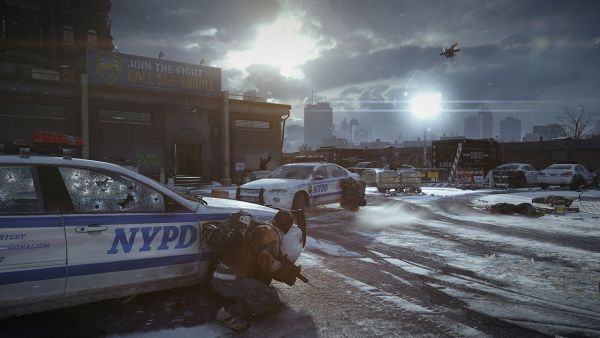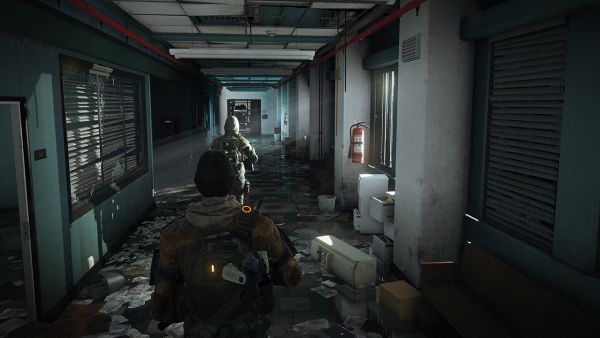
After watching Ubisoft’s E3 2015 playthrough last year, I started up the weekend-long beta for Tom Clancy’s The Division with some vague memories of a very traditional looking third-person shooter with an online mode designed to encourage uneasy alliances. Now that I have played The Division, I can confirm that it does indeed play like most other third-person shooters, and yes, it looks about as uninspiring as most of them, too. Fortunately, The Division’s hook, “The Dark Zone,” does occasionally deliver great, tense moments in which you’ll be wondering which member of your hastily-assembled team is going to try to kill everyone and make off with the loot. And who knows? Sometimes, it might even be you.
Platforms: PC, PS4 (Version Played), Xbox One
Publisher: Ubisoft
Developer: Ubisoft Massive
Genre: Online RPG Shooter
Release Date: March 8, 2016
ESRB Rating: Mature
In The Division, you play as a member of the titular task force, who have been sent into a New York City recently ravaged by a biological attack on Black Friday thanks to banknotes covered with smallpox. Your objective is to investigate the source of the virus and bring some order back to the city. You will attempt to accomplish this task by taking on missions, alone or with a group, to upgrade the three wings of your base of operations: Medical, Tech, and Security. Fiction aside, the real draw of the game is the loot progression, and you can find better guns and gear by doing repeatable and randomly-generated side quests. While the solo and co-op shooting is enjoyable enough, the best weapons – and experiences – can only be found in the Dark Zone.
In the Dark Zone, you can team up with friends and people that you randomly encounter in order to find much better loot. The smallpox pandemic means that these items have to pass through decontamination before you get to use them, and so once you’ve collected a few pieces of loot, you’ll have to call down a helicopter to extract the items and send them back to your stash. The catch here is that in the Dark Zone, anyone can open fire on you at any time (or go “rogue”) and steal all the loot before you get to extract it as calling in the chopper means firing a flare which attracts potential scavengers. This constant threat means that you essentially have to form a team if you want to survive in the Dark Zone, but there’s nothing stopping you or any of your allies from turning against the team at the extraction zone and taking all of the spoils.

When it works, this dynamic can lead to some incredibly tense moments. On a few occasions, I passed the 90 seconds leading up to the helicopter’s arrival by sitting completely still behind a car, reticle trained on my companion, ready to return fire should any come my way. Of course, the tension only increases when there are more players added to the mix. While there is a great deal of paranoia in these cobbled-together crews, coming up against other parties in the Dark Zone can lead to moments of real camaraderie. Seeing a rogue crew rolling toward your extraction zone and mounting an ambush against them with your own team feels awesome, and produces a feeling of solidarity that takes the edge off all of the suspicion.
The shooting in The Division is enjoyable, but is marred by the fact that the enemies take far too many bullets before they go down. It is also disappointing that every character feels the same, though it is hard to tell how representative this is of the full game, as the beta keeps you locked out of the Skill Tree. While I like the look of the game generally – getting caught in a snowstorm looks amazing – the modern military style does not lend itself very well to a loot-driven game. One of the great joys of a game like Diablo is watching your character trade in that leather sash for a Godly Plate of the Whale chest piece, but in The Division, your gun, whether Level 1 or Level 10, just looks like a gun.

Online games are rarely able to create tension and paranoia, and the fact that The Division is occasionally able to do this means that it is so much more disappointing when it fails. For every tense stand-off I sat through, I endured many more frenzies of 15 people cutting each other down, and then respawning close enough to allow them to run back in and join the fray before it ended. The fact that the Dark Zone loot is very easy to collect also causes problems here; after only a few hours with the beta I found that all of the tension had made way for apathy because I knew that, even if I did die and lose all of my loot, it would only take ten more minutes to fill up my backpack again. It seems like many others felt this way, for as the beta drew on, the Dark Zone offered more and more scenes of large groups of people doing endless jumping jacks as they waited for the helicopter to arrive. Realising that after only a day or so the most interesting part of the game had seemingly dried up was saddening, and does not fill me with hope for the full release.
That said, Tom Clancy’s The Division created some of the most interesting online interactions I have had for some time, and, with a few tweaks, might continue to do so. But we’ll have to wait until the game’s full release on March 8 to find out.







